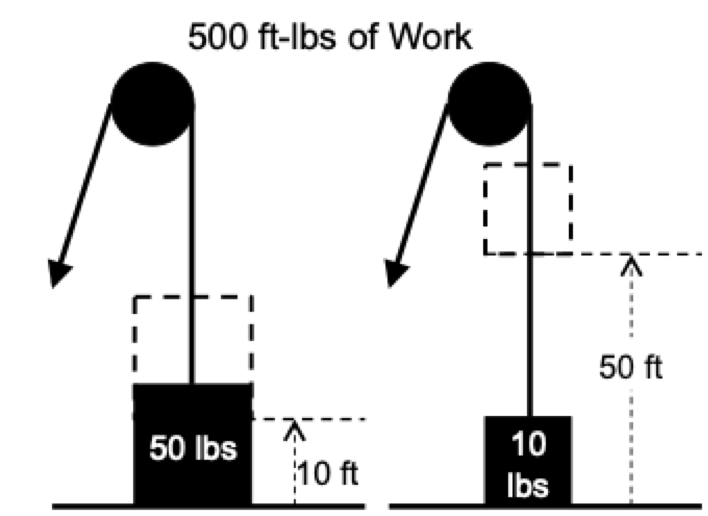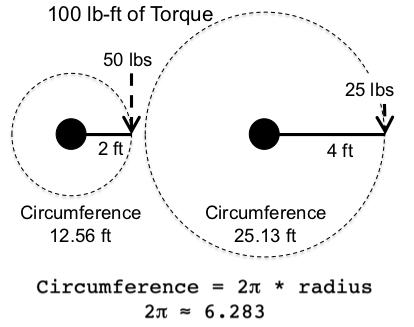Work

Work is how much force is applied for a distance.
Work = Force X Distance
If you lift a 50 lbs box 10 feet off the ground then you do:
50 lbs * 10 ft = 500 ft-lbs of work.
If you lift a 10 lb box 50 ft you still do 500 ft-lbs of work.
10 lbs * 50 ft = 500 ft-lbs.
You can pull hard for a short distance or pull easy for a longer distance and still do the same amount of work.
Torque

Torque is the turning force caused by force acting at a distance. The torque is the force times the distance away from the center that the force is acting around.
Torque = Force * Radius
A 2 ft wrench pulled with 50 lbs applies:
50 lbs * 2 ft = 100 lb-ft of torque.
If you put 25 lbs on a 4 ft wrench you still apply 100 lb-ft of torque
25 lbs * 4 ft = 100 lb-ft.
You can push with more force on a short wrench or push less on a long wrench to apply the same torque.
Rotational Work
When work is done using a rotating machine, the distance that the torque arm has to travel to make a complete revolution is always 2π times the length of the torque arm. So,
Work = Torque * 2π.
If you pull on a wrench applying 100 lb-ft of torque, then you do:
100 lb-ft * 2π = 628 ft-lbs of work each revolution.
If you use a 2 ft long wrench then you have to pull with 50 lbs for 2 ft * 2π = 12.56 ft to complete a revolution. With a 4 ft wrench you pull with 25 lbs for 4 ft * 2π = 25.13 ft.
The work done each revolution is the same as long as the torque is the same.
50 lbs * 12.56 ft = 628 ft-lbs ↔ 25 lbs * 25.13 ft = 628 ft-lbs
You push hard for a shorter distance with the short wrench
You push easier for a longer distance with the long wrench to do the same amount of work.
Power

Power is how much work is done in a given amount of time. When you do 33,000 ft-lbs of work in a minute you are putting out 1 hp.
Hp = Work / Minutes / 33,000
If you do 500 ft-lbs of work by lifting a 100 lb box 5 ft, then to put out 1 hp you need to lift:
33,000 ft-lbs / 500 ft-lbs per box = 66 boxes per minute. That’s a box each 0.9 seconds.
Doing 1,000 ft-lbs of work by lifting a 200 lb box 5 ft needs only half the boxes each minute for 1 hp: 33,000 ft-lbs / 1,000 ft-lbs per box = 33 boxes per minute. That’s 1.8 seconds per box.
Less work quickly, or more work slowly puts out the same horsepower.
The faster you move while pushing with the the same force, the more work you are doing in the same amount of time. As you speed up, it takes more power to maintain the pushing force.
Since Work / Minutes = Force * Distance / Minutes, and 88 ft/min = 1 mph:
Hp = Force * MPH * 88 / 33,000
Or
Hp = Force * MPH / 375
It only takes 1 hp to push with 375 lbs at 1 mph. But it takes 100 hp to push with 375 lbs at 100 mph.
Rotational Power
Turning a 2 ft crank with 50 lbs of force to apply 100 lb-ft of torque does:
100 lb-ft * 2π = 628 ft-lbs of work each revolution of the crank. The crank needs to turn:
33,000 ft-lbs / 628 ft-lbs per rev = 52.5 rpm to put out 1 hp.
If the torque doubles by turning with 100 lbs of force then 1,256 ft-lbs of work is done each revolution. The crank can turn half as fast to put out the same hp:
33,000 ft-lbs / 1,256 ft-lbs per revolution = 26.26 rpm
Low torque at high rpm puts out the same power as high torque at low rpm. A high-speed drive train can be less sturdy than a low-speed drive train and still put out the same hp.
Work, Torque and Power Formulas:
Linear work;
Work = Force * distance (work ft-lbs, force lbs, distance ft)
Rotational force;
Torque = Force * Radius (torque lb-ft, force lbs, radius ft)
Rotational Work;
Work = Torque * 2π (work ft-lbs, torque lb-ft)
Horsepower from linear force and speed;
Hp = Force * MPH / 375
Horsepower from work;
Hp = Work / Time in minutes / 33,000 (work ft-lbs, time minutes)
Hp = Work / Time in seconds / 550 (work ft-lbs, time seconds)
Horsepower from RPM;
Hp = Work * RPM / 33,000
Horsepower from torque;
Hp = Torque * RPM / 33,000 / 2π
so;
Hp = Torque * RPM / 5252